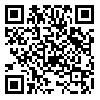Volume 6, Issue 1 (4-2019)
Human Information Interaction 2019, 6(1): 44-52 |
Back to browse issues page
Download citation:
BibTeX | RIS | EndNote | Medlars | ProCite | Reference Manager | RefWorks
Send citation to:



BibTeX | RIS | EndNote | Medlars | ProCite | Reference Manager | RefWorks
Send citation to:
Torkiantabar M, Arzani Z. Evaluate cognitive skills, composition and use of information among graduate students of Islamic Azad University Doruod Branch. Human Information Interaction 2019; 6 (1)
URL: http://hii.khu.ac.ir/article-1-2670-en.html
URL: http://hii.khu.ac.ir/article-1-2670-en.html
Islamic Azad University Doroud Branch
Abstract: (6531 Views)
Background and Aim: This study aimed to evaluate cognitive skills, composition and use of information among graduate students of Islamic Azad University Doruod Branch.
Methods: The research is descriptive. The study sample included 1105 persons of Doruod Islamic Azad University graduate students, which is based on the sample of 286 subjects were selected. To gather data for these study questionnaires were used. The questionnaires were distributed and 276 questionnaires were received that the number of Inventory data extraction and analysis using statistical software was SPSS20. Descriptive statistics of mean and standard deviation and inferential statistics t test was used.
Results: The results showed that the cognitive, composition and use of information among graduate students of Islamic Azad University Doruod higher than average.
Conclusion: The results of this study and other research related to information literacy of students It can be concluded that universities and higher education institutions should pay special attention to students' information literacy and provide grounds for its upgrade.
Methods: The research is descriptive. The study sample included 1105 persons of Doruod Islamic Azad University graduate students, which is based on the sample of 286 subjects were selected. To gather data for these study questionnaires were used. The questionnaires were distributed and 276 questionnaires were received that the number of Inventory data extraction and analysis using statistical software was SPSS20. Descriptive statistics of mean and standard deviation and inferential statistics t test was used.
Results: The results showed that the cognitive, composition and use of information among graduate students of Islamic Azad University Doruod higher than average.
Conclusion: The results of this study and other research related to information literacy of students It can be concluded that universities and higher education institutions should pay special attention to students' information literacy and provide grounds for its upgrade.
References
1. Afshar, A. (2006). Librarianship and information encyclopedia. Supervised by Khosrawi, F. Islamic Republic of Iran documents and library organization.
2. Amani, F., Tafaroji, R. (2014). Measurement of information literacy and skills of using web-based information sources in students of Ardabil University of Medical Sciences. Journal of educational development in medical sciences, 2012-13, 7 (14), 1-10.
3. Alinezhadmohammadabadi, M., Sarmadi, M., Zandi, B., and Shobeiri, S.M. (2011). Information literacy level and its contribution in students' e-learning process. Quarterly of informational studies and public libraries, 17 (2), 337-371.
4. Bigdeli, R., Momtazan, M. (2011). A comparative studying of information literacy between international students and nursing school students of Jundishapur University of Medical Sciences, Abadan branch. Health information management, 8 (4), 524-537.
5. Cullen, R., Clark, M., and Esson, R. (2011). Evidence-based information- seeking skills of junior doctors entering the workforce: An evaluation of the impact of informationliteracy training during pre-clinical years. Health Information and Libraries Journal, 28(2), 119-129. [DOI:10.1111/j.1471-1842.2011.00933.x] [PMID]
6. Dehghan shad, H., Mahmoodi, M. (2012). Studying requirement of teaching media literacy to adolescents from department of education experts' perspective. Quarterly of media studies, 7 (16), 69-82.
7. Hasanzade, R., Asadi, M.H. (2007). The effect of information literacy on students' academic performance. Journal of educational studies, (11), 1-18.
8. Pandpazir, M., Cheshmesohrabi, M. (2010). Studying literacy level of graduate students of Kermanshah University of Medical Sciences based on six great skills model of Eisenberg and Berkowitz. Quarterly of information research and public libraries, 16 (2), 115-137.
9. Mahmoodi, A., Yarifiroozabad, H. (2012). Studying and identifying informational literacy level of academic groups at Islamic Azad University, district 5 . Journal of knowledge, 5 (18), 109-128.
10. Marefat, R., Azodi, M. (2007). Informational literacy standards for higher education students. Book quart
11. erly, (56), 97- 119.
12. Mirjalili, S.H. (2006). Informational literacy; reviewing evolution of literacy in information age. Book quarterly, (56), 109-122.
13. Naderi, M., Shahrabadi, A., Rezaeiyan, M., and Hadavi, M. (2013). Studying informational literacy level of students of Rafsanjan University of Medical Sciences. Journal of Rafsanjan University of Medical Sciennces, 12 (3), 631-640.
14. Nemati, M., Geravand, A., Mousavi amiri, T., and Hashempour, F. (2015). The relationship between informational literacy and students' creativity of LorestanPayamNour University. Journal of knowledge studies, 1 (4), 129-149.
15. Patterson,A.(2009).A need analysis for information literacyprovision for research: a case study in university college Dublin. Journal of information literacy, 3(1), 5-18. Retrieved October 13, ]On-line[ Available: form http://ojs.Ibori.ac.uk/ojs. [DOI:10.11645/3.1.210]
16. Perrin, C.,Delwar, H., and Cumming, K.(2008). Nursing Students' Information literacySkills Prior to and After Information Literacy Instruction. 2010, RetrievedAugust 18, from http://www.biomedsearch.com/sci/Nursing-students-information-literacy- skills /0003346481. html.
17. Salisbury, F., Ellis J. Online and face - to- face: evaluating methods for teaching information literacy skills to undergraduate arts students. Library Review, 2003,52(5):209-17. [DOI:10.1108/00242530310476715]
18. Sarmad, Z., Bazargan, A. (2010). Research methodologies in behavioral sciences. Tehran: Agah publication.
19. Zamani, A. (2004). Information literacy standards. Informational quarterly, 19 (1-2), 34-41.
Send email to the article author
| Rights and permissions | |
 | This work is licensed under a Creative Commons Attribution-NonCommercial 4.0 International License. |






